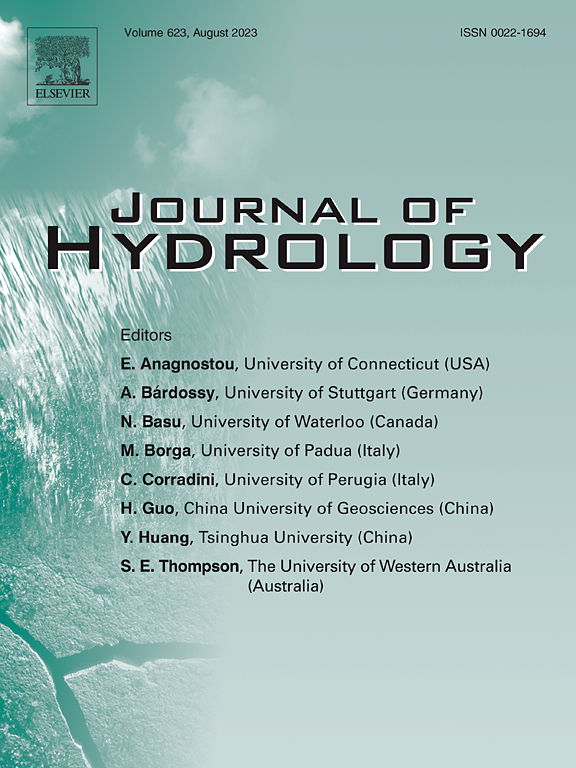估算美国邻近地区的灌溉耗用:将卫星来源的实际蒸散估算与国家水文模型相结合
IF 6.3
1区 地球科学
Q1 ENGINEERING, CIVIL
引用次数: 0
摘要
灌溉消费使用是水资源管理的关键资料,而大多数区域和国家评估一般没有这方面的资料。从2000年到2020年,在12位水文单位代码的分水岭水平上,对美国相邻地区的每日消耗使用量进行了估计。利用谷歌Earth Engine上的OpenET工具中的简化表面能量平衡模型,从Landsat陆地表面温度数据中得出实际蒸散估算值。这些估计值被映射到由Landsat灌溉数据集(LANID)定义的灌区的国家水文模型(NHM)空间单位。NHM允许同时估计消耗利用和有效降水。将结果与2015年美国地质勘探局的用水报告进行比较,发现年用水量最大差异为37 cm,平均绝对差异为13 cm,偏差为2.7%。利用文献中报道的效率,比较了全国4个主要灌区的种植者报告的田间分辨率灌溉提水量。这些比较导致均方根误差在每年10 -18 厘米之间,偏差为- 18.2至15.8%。这些不同报告估计数的显著差异表明,在准确的数据可得性和评估中使用的方法和定义不一致方面存在挑战。在美国,由于干旱,特别是在严重依赖降水的地区,年用水量的变化可能会达到37%。在过去的20年里,西部各州的用水量显著增加,尤其是2010年至2020年的科罗拉多河流域,加剧了供水的下降。本文章由计算机程序翻译,如有差异,请以英文原文为准。
Estimating irrigation consumptive use for the conterminous United States: coupling satellite-sourced estimates of actual evapotranspiration with a national hydrologic model
Irrigation consumptive use is crucial information for water resource management and this information is generally not available for most regional and national assessments. From 2000 to 2020, daily estimates of consumptive use were produced for the conterminous U.S. at the 12-digit hydrologic unit code watershed level. Using the Simplified Surface Energy Balance model within the OpenET tool on Google Earth Engine, actual evapotranspiration estimates were derived from Landsat land surface temperature data. These estimates were mapped to the National Hydrologic Model (NHM) spatial units for irrigated areas defined by the Landsat Irrigation Dataset (LANID). The NHM allows for simultaneous estimation of consumptive use and effective precipitation. Results were compared to the 2015 USGS water use report, revealing annual maximum difference in consumptive use of 37 cm, with an average absolute difference of 13 cm and a bias of 2.7 %. Comparisons to field resolution irrigation withdrawals reported by growers in 4 major irrigation regions across the nation were made using efficiencies reported in the literature. These comparisons resulted in root mean square errors that ranged between 10 and 18 cm per year and biases of −18.2 to 15.8 %. Significant differences in these different reported estimates represent challenges in accurate data availability and inconsistent methods and definitions used in assessments. Annual consumptive use in the U.S. can vary by 37 % due to droughts, particularly in regions more heavily dependent on precipitation. Significant increases in consumptive use were noted over the 20-year period in western states, especially the Colorado River basin from 2010 to 2020, exacerbating water supply declines.
求助全文
通过发布文献求助,成功后即可免费获取论文全文。
去求助
来源期刊

Journal of Hydrology
地学-地球科学综合
CiteScore
11.00
自引率
12.50%
发文量
1309
审稿时长
7.5 months
期刊介绍:
The Journal of Hydrology publishes original research papers and comprehensive reviews in all the subfields of the hydrological sciences including water based management and policy issues that impact on economics and society. These comprise, but are not limited to the physical, chemical, biogeochemical, stochastic and systems aspects of surface and groundwater hydrology, hydrometeorology and hydrogeology. Relevant topics incorporating the insights and methodologies of disciplines such as climatology, water resource systems, hydraulics, agrohydrology, geomorphology, soil science, instrumentation and remote sensing, civil and environmental engineering are included. Social science perspectives on hydrological problems such as resource and ecological economics, environmental sociology, psychology and behavioural science, management and policy analysis are also invited. Multi-and interdisciplinary analyses of hydrological problems are within scope. The science published in the Journal of Hydrology is relevant to catchment scales rather than exclusively to a local scale or site.
 求助内容:
求助内容: 应助结果提醒方式:
应助结果提醒方式:


